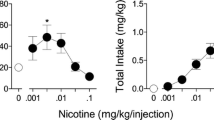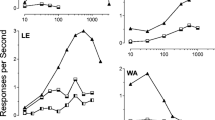Abstract
Rationale
Methods for establishing robust long-term self-administration of intravenous (i.v.) nicotine, the primary psychoactive agent in tobacco, are not well-established in laboratory animals.
Objective
Here, we examine the use of a fading procedure to establish robust and consistent i.v. nicotine self-administration under second-order schedule conditions in squirrel monkeys.
Methods
First, self-administration behavior was developed in two groups of male squirrel monkeys using a second-order fixed-interval 5-min schedule with fixed-ratio 5 units (FI 5-min (FR5: S)). Comparable performances were maintained by i.v. cocaine (0.032 mg/kg/injection (inj); group A, n = 3) and the combination of food delivery (20–30 % condensed milk) and 0.01 mg/kg/inj i.v. nicotine (group B, n = 3). Subsequently, the concentration of condensed milk was gradually reduced to zero in the second group and self-administration behavior was maintained by i.v. nicotine alone. Next, self-administration of a range of doses of i.v. nicotine (0.001–0.032 mg/kg/inj) and, in additional experiments, the minor tobacco alkaloid anatabine (0.01–0.18 mg/kg/inj) was studied in both groups.
Results
Results show that nicotine and anatabine had reinforcing effects in both groups. However, optimal doses of nicotine and anatabine maintained significantly higher rates of i.v. self-administration behavior in subjects trained with the fading procedure than in subjects provided with a history of cocaine-maintained responding.
Conclusion
These results illustrate conditions under which robust i.v. nicotine self-administration can be established in squirrel monkeys and the influence of prior experimental history in the expression of reinforcing effects of nicotine and anatabine.






Similar content being viewed by others
Abbreviations
- ANOVA:
-
Analysis of variance
- FI:
-
Fixed-interval
- FR:
-
Fixed-ratio
- TO:
-
Time-out
References
Bardo MT, Green TA, Crooks PA, Dwoskin LP (1999) Nornicotine is self-administered intravenously by rats. Psychopharmacology 146:290–296
Benowitz NL (2010) Nicotine addiction. N Engl J Med 362:2295–2303
Bergman J, Johanson CE (1986) The reinforcing properties of diazepam under several conditions in the rhesus monkey. Psychopharmacology 86(1-2):108–113
Caine SB, Collins GT, Thomsen M, Wright C, Lanier RK, Mello NK (2014) Nicotine-like behavioral effects of minor tobacco alkaloids nornicotine, anabasine, and anatabine in male rodents. Exp Clin Psychopharmacol 22(1):9–22
Desai RI, Bergman J (2010) Drug discrimination in methamphetamine-trained rats: effects of cholinergic nicotinic compounds. J Pharmacol Exp Ther 335(3):807–816
Desai RI, Bergman J (2014) Methamphetamine-like discriminative-stimulus effects of nicotinic agonists. J Pharmacol Exp Ther 348(3):478–488
Goldberg SR, Spealman RD, Goldberg DM (1981a) Persistent behavior at high rates maintained by intravenous self-administration of nicotine. Science 214:573–575
Goldberg SR, Kelleher RT, Goldberg DM (1981b) Fixed-ratio responding under second-order schedules of food presentation or cocaine injection. J Pharmacol Exp Ther 218:271–281
Goldberg SR, Spealman RD, Risner ME, Henningfield JE (1983) Control of behavior by intravenous nicotine injections in laboratory animals. Pharmacol Biochem Behav 19:1011–1020
Goodwin AK, Hiranita T, Paule MG (2015) The reinforcing effects of nicotine in humans and nonhuman primates: a review of intravenous self-administration evidence and future directions for research. Nicotine Tob Res 17(11):1297–1310
Haney M, Spealman R (2008) Controversies in translation research: drug self-administration. Psychopharmacology 199(3):403–419
Harris AC, Tally L, Muelken P, Nanal A, Schmidt CE, Cao Q, LeSage MG (2015) Effects of nicotine and minor tobacco alkaloids on intracranial-self-stimulation in rats. Drug Alcohol Depend 153:330–334. doi:10.1016/j.drugalcdep.2015.06.005
Hoffman AC, Evans SE (2013) Abuse potential of non-nicotine tobacco smoke components: acetaldehyde, nornicotine, cotinine, and anabasine. Nicotine Tob Res 15(3):622–632
Howell LL, Fantegrossi WE (2009) Intravenous drug self-administration in nonhuman primates. In: Buccafusco JJ (ed) Methods of behavior analysis in neuroscience, 2nd edn. CRC Press, Boca Raton (FL), Chapter 9
Justinova Z, Goldberg SR, Heishman SJ, Tanda G (2005) Self-administration of cannabinoids by experimental animals and human marijuana smokers. Pharmacol Biochem Behav 81(2):285–299
Katz JL, Goldberg SR (1988) Preclinical assessment of abuse liability of drugs. Agents Actions 23(1):18–26
Kelleher RT, Morse WH (1968) Determinants of the specificity of behavioral effects of drugs. Ergeb Physiol Biol Chem Exp Pharmakol 60:1–56
Koffarnus MN, Winger G (2015) Individual differences in the reinforcing and punishing effects of nicotine in rhesus monkeys. Psychopharmacology 232:2393–2403
Le Foll B, Goldberg SR (2009) Effects of nicotine in experimental animals and humans: an update on addictive properties. Handb Exp Pharmacol 192:335–367
Le Foll B, Wertheim C, Goldberg SR (2007) High reinforcing efficacy of nicotine in non-human primates. PLoS ONE 2(2):e230
Mello NK, Fivel PA, Kohut SJ, Caine SB (2014) Anatabine significantly decreases nicotine self-administration. Exp Clin Psychopharmacol 22(1):1–8
National Research Council (2011) Guide for the care and use of laboratory animals, 8 edn. The national academies press, Washington, D.C.
Nader MA, Mach RH (1996) Self-administration of the dopamine D3 agonist 7-OH-DPAT in rhesus monkeys is modified by prior cocaine exposure. Psychopharmacology 125(1):13–22
Platt DM, Carey G, Spealman RD (2005) Intravenous self-administration techniques in monkeys. Curr Protoc Neurosci. doi:10.1002/0471142301.ns0921s32, Chapter 9:Unit 9.21
Reavill C, Spivak CE, Stolerman IP, Waters JA (1987) Isoarecolone can inhibit nicotine binding and produce nicotine-like discriminative-stimulus effects in rats. Neuropharmacology 26:789–792
Reavill C, Jenner P, Kumar R, Stolerman IP (1988) High affinity binding of [3H] (-)-nicotine to rat brain membranes and its inhibition by analogues of nicotine. Neuropharmacology 27:235–241
Samson HH, Tolliver GA, Pfeffer AO, Sadeghi K, Haraguchi M (1988) Relation of ethanol self-administration to feeding and drinking in a nonrestricted access situation in rats initiated to self-administer ethanol using the sucrose-fading technique. Alcohol 5(5):375–385
Slifer BL, Balster RL (1985) Intravenous self-administration of nicotine: with and without schedule-induction. Pharmacol Biochem Behav 22:61–69
Spealman RD, Goldberg SR (1982) Maintenance of schedule-controlled behavior by intravenous injections of nicotine in squirrel monkeys. J Pharmacol Exp Ther 223:484–491
Spealman RD, Goldberg SR, Gardner ML (1981) Behavioral effects of nicotine: schedule-controlled responding by squirrel monkeys. J Pharmacol Exp Ther 216:484–491
Stolerman IP, Garcha HS, Mirza NR (1995) Dissociations between the locomotor stimulant and depressant effects of nicotinic agonists in rats. Psychopharmacology 117:430–437
Xiao Y, Meyer EL, Thompson JM, Surin A, Wroblewski J, Kellar KJ (1998) Rat alpha3/beta4 subtype of neuronal nicotinic acetylcholine receptor stably expressed in a transfected cell line: pharmacology of ligand binding and function. Mol Pharmacol 54(2):322–333
Acknowledgments
We thank Dr. R.D. Spealman for his comments on an earlier version of this manuscript.
Authorship contributions
R.I. Desai and J Bergman participated in research design for behavioral experiments. R.I. Desai and K.A. Sullivan conducted the experiment. R.I. Desai and K.A. Sullivan performed behavioral data analysis. R.I. Desai, K.A. Sullivan, and J Bergman wrote or contributed to the writing of the manuscript. S.J. Kohut provided in vitro binding data for anatabine. R.I. Desai acquired funding for the research.
Author information
Authors and Affiliations
Corresponding author
Ethics declarations
Role of funding source
This work was supported by NIH/NIDA grant DA031231. The funding source had no further role in the following: study design, collection of data, analysis of data, interpretation of data, and writing and submission of report for publication. The authors declare that, except for income received from our primary employer and, for JB, from LWW for editorial duties, no other financial support or compensation has been received from any individual or corporate entity over the past 3 years of research or professional services, and there are no personal financial holdings that could be perceived as constituting a potential conflict of interest.
Conflict of interest
The authors declare that they have no conflict of interest.
Rights and permissions
About this article
Cite this article
Desai, R.I., Sullivan, K.A., Kohut, S.J. et al. Influence of experimental history on nicotine self-administration in squirrel monkeys. Psychopharmacology 233, 2253–2263 (2016). https://doi.org/10.1007/s00213-016-4274-1
Received:
Accepted:
Published:
Issue Date:
DOI: https://doi.org/10.1007/s00213-016-4274-1




